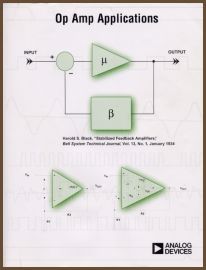
Op Amp Applications
Edited by Walt Jung
Analog Devices, 2002
970 pages, softcover
ISBN 0-916550-26-5
$40.00 direct
Book reviewed 2004.09.10, updated 2004.10.04 after an email from Walt Jung with corrections
When I first heard of this book, I expected that it would be the Analog Devices version of TI's Op Amps for Everyone. There are several superficial parallels. Both books are edited and coauthored by engineers at their respective companies, both of whom are well known as a result of their previous magazine articles and app notes. Both books also cover the same basic topic, and they came out at around the same time. (The first edition of Op Amps for Everyone actually pre-dates this book, despite the difference in copyright dates of the current editions.) The natural expectation of similarity is unfounded, however: these are very different books.
The book's material was written at various times over a period of at least a decade, by several different authors. Much of it comes from earlier Analog Devices application notes and seminar materials. (Walt Jung says, "ample new material [was] created just for this book.") The jumps in writing style make the many voices that went into the book obvious. The book also lacks the unity of design of Op Amps for Everyone. For instance, the schematics are in several different styles, and even the most common style has variances between drawings, such as different line weights. I don't mean to imply that this is a major problem, but it is illustrative of the fact that a professional book production team wasn't involved. There's a certain polish that a team of graphic artists, page layout pros, English majors, etc. can produce that is beyond the ability of most engineers.
One big of advantage Op Amps for Everyone is that the paper book is just a printed version of a TI app note that you can download for free from TI's web site. While some of the material in Op Amps Applications is downloadable from Analog Devices' web site, the complete work is not. (Walt Jung reports that he has asked ADI to offer it for download, but they have so far refused.) Also, much of the downloadable material isn't easy to find, as it isn't directly linked through the web hierarchy — you pretty much have to know it's there already.
The book is twice as long as Op Amps for Everyone, yet it only has eight chapters, while Op Amps for Everyone has nineteen. This makes it hard to remember where material you've used before is in the book. Since the main table of contents just lists the chapter titles (no subsection breakout), you end up using the index to find things every time. By contrast, I've memorized the chapter numbers of the most useful sections in Op Amps for Everyone and in The Art of Electronics, because each one is so well focused.
Since I can't point to a "favorite chapter" like I did for Op Amps for Everyone, I'll just point out some interesting subsections. One is the noise analysis section, which is more detailed than the corresponding chapter Op Amps for Everyone so I do refer to it frequently when the former's lighter treatment runs out of steam. I also refer to this book for more technical explanations of datasheet parameters when the simpler explanations in Op Amps for Everyone are insufficient. And I must say, the chapter on op-amp history is fascinating reading, though it doesn't make the book a history reference.
My biggest disappointment with this book is that, since it was edited by Walt Jung, I expected it to contain the complete catalog of all the great circuits he's published over the years, in expanded form. Yes, some of his circuits are here, but usually only one exemplar of each type, and the explanatory material is shallower than in previous publications. Thus, you will still need to collect together all of his previous publications, rather than expect to find everything in this one volume. This is unfortunate since a book would have allowed for a deeper treatment of some of his previous topics than, for instance, the limited space in a magazine column. (See below for pointers to sources for this earlier material.)
The Bottom Line
Is this book useful? Yes. Is it a good introduction to op-amps? Definitely not. If you've already read Op Amps for Everyone and are wanting a deeper treatment, this is a reasonable follow-on book if you can spare the $40. If I lost my copy, I'd probably get around to replacing it eventually, but I wouldn't do it quickly. I find that I refer to Op Amps for Everyone a lot more often, because it is easier to find things in it, and the presentation is more accessible.
Op Amps Applications isn't available in bookstores. You can get it direct from Analog Devices by phone (1-800-262-5643) or from their online store. The product code is OP-AMP-APPLIC-BOOK. Your local Analog rep may also be able to get you a copy, if dealing direct with Analog isn't possible for some reason. Perhaps one day this book will be picked up by a major publishing house, and they will put a technical writer and a graphic artist on the job to unify the book's text and graphics. That, and being able to get it from book stores would be most welcome.
Related Resources
Walt Jung's web site has a lot of his other works available in downloadable form, and information on other works that are still available in print. This is a big help when building your collection of his previous publications.
Analog has a review of the book.